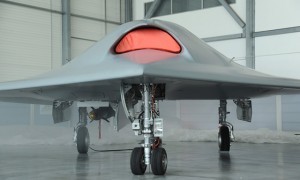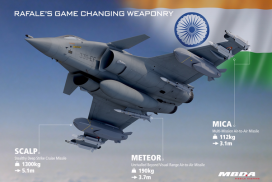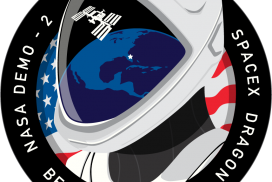 Since the official unveiling of the nEUROn, Europe’s Dassault-led stealth UCAV to the partner nations France, Greece, Italy, Spain, Sweden and Switzerland early this year on 19 January, its maiden flight is expected to be conducted in mid 2012. Final assembly activities on the programme’s lone aircraft were completed recently at Istres air base in southern France, and the platform has already undergone ground tests on its electrical, fuel and hydraulic systems.
Since the official unveiling of the nEUROn, Europe’s Dassault-led stealth UCAV to the partner nations France, Greece, Italy, Spain, Sweden and Switzerland early this year on 19 January, its maiden flight is expected to be conducted in mid 2012. Final assembly activities on the programme’s lone aircraft were completed recently at Istres air base in southern France, and the platform has already undergone ground tests on its electrical, fuel and hydraulic systems.
The nEUROn, whose shape reminds of the American X-47B, is the first stealth combat drone developed in Europe as a technology demonstration effort, led by the French defence ministry since its launch in 2003. Following the first flight a testing campaign in France, Sweden and Italy will begin to evaluate the handling of the drone, its stealthiness, its capability to drop Precision Guided Munitions through the internal weapon bay using a targeting and delivery system developed by Alenia, as well as the integration in a C4i environment (command, communication control, computer and intelligence).
The nEUROn demonstrator will provide the European design offices with a project allowing them to develop know-how and to maintain their technological capabilities in the coming years. According to Dassault Aviation this project goes far beyond the theoretical studies that have been conducted until now, as it plans the building and the flight demonstration of an unmanned aircraft and it is also a way to implement an innovative process in terms of management and organization of a European cooperative programme.
The French Defence Procurement Agency (DGA –Délégation Générale pour l’Armement), and a single point of implementation, Dassault Aviation company as prime contractor, were settled to manage the nEUROn programme. Speaking at an unveiling ceremony at Istres, Dassault chief executive Charles Edelstenne urged the programme’s partner nations to begin discussing a possible follow-on project for a production system.
The demonstration goals of nEUROn are the followings: the performance of an air-to-ground mission based on the detection; localization, and reconnaissance of ground targets in autonomous modes; the evaluation of the detection results of a stealth platform facing ground or aerial threats; in terms of radar cross section and infrared signature; the weapon release from an internal bay, with the very stringent tempo constraints of a fast decision loop.
It is clear that through these demonstration missions, the goals are to validate technologies around command and control of an unmanned air vehicle of a size similar to a combat aircraft, with all back-up modes insuring necessary safety and security. Europe’s emerging UCAV sector remains fragmented, with a separate co-operation agreement between Dassault and the UK’s BAE Systems to potentially compete with Alenia and EADS for future orders. BAE also expects to perform the first flight of the UK’s Taranis UCAV technology demonstrator later this year.



